To discover history is rarely dull and the Thousand Island’s Hill Island Lot #7 is, definitely, no exception! In fact, its history has links to monsters and murderers.
In the 1980s, I completed a contract for Parks Canada to inventory historic recreation sites in the Canadian sector of Thousand Islands. I had visited the property shortly before the old mansion and boathouse were taken down by Parks Canada as part of their management plan. Since then, I have wanted to tell its story. When I was putting my notes together, I received this note from a TI Life reader:
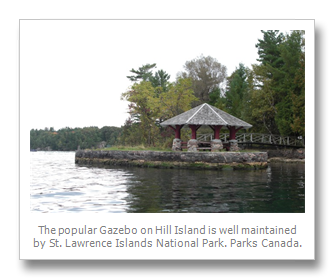
“I am hopeful to learn the history of what is now a Parks Canada property,with dock, on the point east of the "Limberlost" coast guard station. This point is referred to by some locals as Bannerman's Point. When I was a kid, around 1960, we used to take my great aunt's rowboat from her nearby Hill Island cottage and explore an old abandoned estate on the point. The estate consisted of a main house, a guest or servant's house and a boathouse with at least two slips. There were two mahogany runabouts sunk in their slips sitting at the bottom of the river. It was rumored that a caretaker lived in the guest house, so we tried to be covert. The "Point" is on the NE side of Hill Island just west of Club Island. I remember the name "Bird" or "Byrd" mentioned by some of my old relatives as having been the original owners of the estate”. Mike Heberling, Hill Island
A few days later I sent Mike my notes. Soon, Mike and his wife Gayla, and I, were completely engrossed in gathering our clues. As Gayla had found a reference to the murder of Marjorie Winifred Bird in a Time Magazine article and I had found an in-depth article in the Saturday Evening Post, we were on our way!
The first printed reference to Lot 7 on Hill Island1 is found at Library and Archives Canada - www.collectionscanada.gc.ca. In 1874, Charles Unwin, a Public Land Surveyor, provided the Department of Indian Affairs with a survey and map of the Canadian sector of Islands. He wrote, “Parcel No. 72. Is occupied by John Hoadley; is said to contain 32.4 acres, about twelve of which is cleared, half of which is surrounded by marsh, a portion of the measured land being now covered by water; soil is inferior; balance is all rock, no timber. Value $1 per acre.”
Unwin calculated that the property could fetch up to $900, if sold at auction, and only $50 if it was on the mainland. John Hoadley was given the patent3 for the island in 1877 and in 1889 he, or his heirs, sold the property to William H. Hunt, a local farmer who also owned other Hill Island farms. Subsequently the island was sold to J.G. Fairchild.
To date, both Gayla and I have been unsuccessful in finding biographical information about J.G. Fairchild. Maybe we had the wrong initials! In 1898 Frank H. Taylor published a map of the Thousand Islands which identified over 109 properties by number. Each number was listed with the name of the property owner and their home city. Number 81 is identified as “Fairjoline”, owned by F.D. Fairchild, Leavenworth, Kansas.
We were fortunate to uncover a F.D. Fairchild4 in Leavenworth KS, a wealthy industrialist. Fairchild hired Frank Townsend Lent, an American architect living in Gananoque, to design a mansion. Gananoque’s Mitchell and Wilson Construction Company completed the building. Lent was an authority on summer-cottage construction and published the popular: Summer Homes And Camps: Containing Suggestions, Hints, And Practical Ideas, Sketches, Plans, Etc. For The Building Of Summer Houses (1899). The style of Fairjoline definitely resembled many of Lent’s summer cottages. [A more in-depth review of Frank Townsend Lent can be found in the 2004 exhibition catalogue published by Queen's University and titled: Ah, Wilderness! Resort Architecture in the Thousand Islands5.]
The next recorded owner of the island was Sara E. Batterman, who was married to Henry Batterman. Batterman owned Batterman’s Department store in Brooklyn NY. He was also the president of the Broadway Bank, located next door to his store. When Sara Batterman purchased the island her registered deed showed that the home came with “a steam launch, 3 skiffs, and a billiard table”. From then on the property was known as Batterman’s Point. Henry died in January 1912 and thanks to Gayla, we found a number of references to the Batterman’s, including Henry Batterman’s obituary6 from the New York Times.
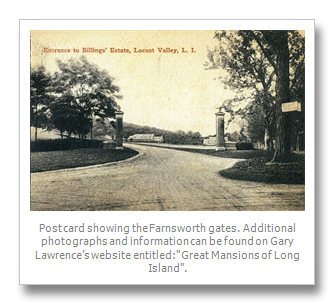
The next registered owner of Batterman’s Point was A. B. Nichols. Gayla suggests that he may have been related to Sara Batterman’s daughter’s husband, C. Walter Nichols. Over the next eight years the property changed hands twice. From Nichols to H. Hinck, then in 1921 to Wallis Clinton Bird, an heir to the Standard Oil fortune7 and a “sportsman”. Bird owned the 65-acre Farnsworth Estate8 on north shore of Long Island, originally built for C.K.G. Billings by architect, Guy Lowell in 1914. Bird had an infatuation with automobiles9 and his rarely-driven collection of classic cars was considered to be the most extensive of its time. He owned at least 17 cars and had a 27-car garage.
We have no references to Bird’s social life at Batterman’s Point. We do know that he hired Mitchell and Wilson to do extensive renovations to the mansion and boathouse. He summered in the islands until his untimely death in 1941 – he was killed in a small-plane crash while flying from Long Island to the Thousand Islands. Bird’s widow, Marjorie Winifred10, had been a Ziegfeld Follies dancer in New York City. Winnie, 44 years old when her husband died, was born in Missouri and she liked to live the “good life”. Press clippings indicate she was left an annual income of $300,000. At the end of World War II she abandoned her Long Island and Hill Island properties. She went to Europe where she divided her time between Paris and Lausanne.
In 1950 Winnie met her “Prince Charming”, a self-styled-Romanian Prince named Nicolas Sturdza. She paid him $1,000 a week to escort her on the social scene - his crown and her initials engraved on her handbags. Apparently, the “Prince” he had a flair for designing clothes. Winnie set him up in the “Boutique Nicky” on Paris' fashionable Faubourg St.-Honoré” .11
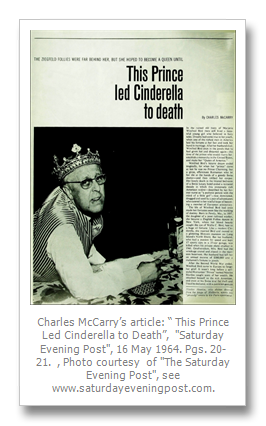
Charles McCarry12 wrote, in the Saturday Evening Post, a most- titillating record of Winnie Bird’s last days, “She smoked 80 cigarettes a day and drank thirstily. She kept exotic tropical birds and fish but they died for lack of food… When she refused to sign checks, Sturdza forged some to meet current expenses.” McCarry reported that “Nicolas had arranged for Gerard Savoy, a physician who had already lost his medical license, to treat her with a massive dose of barbiturates…Then in June, Savoy cut off her supply of barbiturates. She had taken 7,750 pills in the preceding nine months.” Marjorie Winifred Bird died on July 22, 1961. After her death, hotel servants were ready to tell interested journalists how Mrs. Bird drank hot chocolate containing 12 beaten eggs at midnight, or how she lived on a diet of spaghetti and fruit, or how she sent back an entire dinner because the green beans were an inch too short.”
Dr. Savoy and Nicholas Sturdza were accused of murder and their trial took place during the winter of 1964. The news media reported that “ The wealthy American was murdered for her jewels and fortune.” The accused were found guilty and their sentences were on the “light” side. Sturdza was convicted of fraud and theft and sentenced to four years in prison. Dr. Savoy was sentenced to seven years in prison.
During Winnie Bird’s absence from Batterman’s Point the house declined. Soon after her death the property was sold to W. Grant Mitchell. He renamed the property “Limberlost”13 after a novel (and movies) written by naturalist Gene Stratton-Porter. Mr. Mitchell was a life resident of Jefferson County and is best known as “Mr. Thousand Islands”. He promoted the construction of the Thousand Islands Bridge and was executive secretary of the Bridge Authority from 1938 to 1978.
Mitchell renovated the caretaker’s cottage and his son, Charles, told us about some of the history during his time at the property. The three skiffs were used, the woodland and protected bay was appreciated, as was the lovely cottage. However the mansion was beyond repair and over time slowly but surely the property’s assets were stolen, or removed.
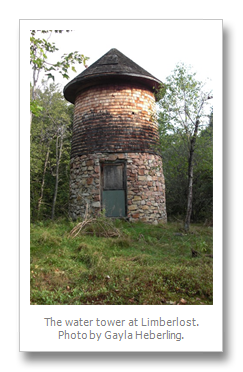
By the end of the 1970s it was ready for its last hurrah – it was the location of a horror movie. The Mitchell family remember the movie as being a made-for-TV Canadian film, However when we looked it up on the internet we found some incredibly-positive memories – “that it was the scariest movie ever!” “The World Beyond”14 was directed by Noel Black, written by Art Wallace and released in January 1978. The story line reads: “Sportswriter Paul Taylor, after a near-death experience on the operating table, can hear the voices of the recently dead. These voices direct him to people who need help from supernatural dangers. In this story, his mission takes him to a remote Canadian island haunted by a creature made from mud and clay. The only thing which can harm this mud golem is salt.” Read some of the reviews15. Unfortunately we can’t locate a copy… perhaps someday we will.
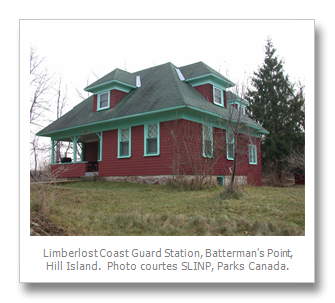
The property is now owned by Parks Canada as part of the St. Lawrence Islands National Park. The mansion and the boathouse were removed in the 1980s. A new gazebo was erected on the hill but off in the woods, a magnificent stone and cedar water tower remains standing. The caretaker’s cottage is now used by the Canadian Coast Guard. Although Gayla and Michael Heberling and I now have more answers to their questions… we don’t have them all – so we will continue.
By Susan Smith with Gayla and Michael Heberling
susansmith@thousandislandslife.com
This article on Batterman’s Point would not have been possible without the help of Gayla and Michael Heberling. The Heberling’s live on Hill Island in the summer and in Texas in the winter. We also thank Charles and Tom Mitchell who shared their remembrances with us and for sharing their photographs. While doing our research we corresponded with Saturday Evening Post and learned more about this 300-year-old magazine. See http://www.saturdayeveningpost.com/ for details.
If you have memories of Batterman’s Point, please post them in our comment section. And if you have photographs, by all means, send them to TI Life.
[mp1]Then locally known as La Roux’s Isle, but originally named in 1818 after Sir Roland Hill, who fought in the Peninsular Wars under Sir Arthur Wellesley, the Duke of Wellington. See [/mp1]
[mp2]RG10, Vol. 2002, File 7506. There are nine photographic references in the Canadian Archive.[/mp3]
2 Leeds County, Land Registry Office, Front of Escott Township, Island in the St. Lawrence River, Hill Island, Land Abstract.
6 Published: January 11, 1912. Copyright © The New York Times
8 To learn more about the Wallis C. Bird mansion, Farnsworth, on Long Island, see
Gary Lawrence’s website.
7 “Switzerland: Room Service in Lausanne”, TIME, April 3,, 1964.
12 Charles McCarry, “ This Prince Led Cinderella to Death”, Ibid.
11 “Switzerland: Room Service in Lausanne”, Ibid.
[mp13]Thanks to Charles Mitchell and his son, Tom, for providing information about the Mitchell family. [/mp13
14 IMDb 20 : “The World Beyond” TV, 1978.
Internet Movie Database
]